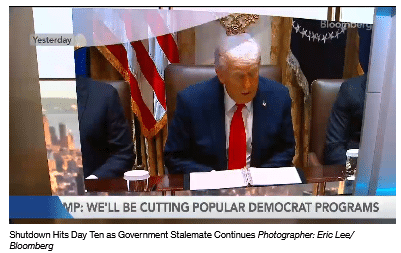
- Air travel, taxpayer services and national parks are among the first government functions to feel the strain of a prolonged impasse, with some agencies implementing a sort of rolling blackout of services to conserve funds and respond only to emergencies.
- More than a quarter million federal employees missed scheduled paychecks this week, with another 2 million expected to go without by next week, and the Pentagon’s next military payday could prove a political flash point if troops begin missing pay for the first time in decades.
- Economists estimate that the shutdown could shave 0.1 to 0.2 percentage points off gross domestic product for each week it continues, with the impact magnified because the government’s data flow has largely gone dark.
The first week of a government shutdown is usually the easy one. It only gets harder after that. As the standoff between President Donald Trump and Congress stretches into its second week — and with no end in sight — the real-world impacts of the shutdown are starting to rise.
Air travel, taxpayer services and national parks are among the first government functions to feel the strain of a prolonged impasse, and some agencies have implemented a sort of rolling blackout of services to conserve funds and respond only to emergencies.

More than a quarter million federal employees missed scheduled paychecks this week, with another 2 million expected to go without by next week. The Pentagon’s next military payday, Oct. 15, could prove a political flash point if troops begin missing pay for the first time in decades.
Early Pain Points
Air travel is emerging as the most visible strain. Flight delays linked to air-traffic-control staffing shortfalls have hit airports from Dallas to Chicago to Washington, DC.
Transportation Secretary Sean Duffy said staffing shortages usually account for about 5% of delays, as air traffic controllers slow traffic to ensure safety. Now those shortages are the cause of more than half of late flights. The US Travel Association estimates $1 billion in lost spending each week.
Taxpayer services are contracting after the IRS furloughed nearly half its staff when carryover funds ran out. Roughly 34,000 employees were sent home this week, while about 40,000 remain on duty preparing for next year’s filing season and implementing Trump’s new tax law. The Taxpayer Advocate Service has shut down entirely.
Food programs could be next in line. The $8 billion Women, Infants and Children nutrition program is being sustained by a $150 million contingency fund that’s nearly gone. The White House has said tariff revenue will be tapped to keep it afloat, but hasn’t explained how or when those transfers would occur. Supplemental Nutrition Assistance Program benefits — food stamps for 41 million Americans — are funded through the end of October.
Some national parks are open but with bare-bones staffing and limited sanitation services, with the impact varying state by state. Cooperative agreements with state governments can keep some parks open using non-federal funds, but others will be closed completely. Smithsonian museums and the National Zoo will close Oct. 11.
Homeowners in flood-prone areas may find themselves without coverage during hurricane season because of a lapse in the National Flood Insurance Program, which cannot issue new policies or renew expiring ones.
A Dynamic Shutdown
After a 35-day holiday shutdown stretching into 2019, the Government Accountability Office faulted the Trump administration for failing to plan for a prolonged lapse in funding.

Some workers are being furloughed and recalled as needed to balance conflicting mandates. The law forbids agencies from spending money not approved by Congress, but the lack of funding doesn’t always delay legal deadlines or prevent emergencies.
So Justice Department lawyers are furloughed as long as their court cases are on hold — but are being called back in cases where judges are declining continuances. And IRS workers could be called back as the tax filing season nears.
Some agencies were able to get around the Antideficiency Act by using special funds that didn’t expire at the end of last year. But those funds are being quickly depleted.
At the Environmental Protection Agency, some furlough notices went out starting Wednesday night, according to the agency’s largest union. EPA’s contingency plan calls for almost 90% of employees to be furloughed once funds lapse, halting most enforcement and permitting.
More so than during previous shutdowns, the second Trump administration is also rewriting the playbook based on new legal interpretations. The Department of Homeland Security anticipated a prolonged lapse and had plans to bring back almost 1,800 workers for the second week — mostly in top-level management, Coast Guard and Customs and Border Protection.
Economic Fallout
Economists estimate that the shutdown could shave 0.1 to 0.2 percentage points off gross domestic product for each week it continues. The impact is magnified this time because the government’s data flow has largely gone dark.

The Bureau of Labor Statistics postponed last week’s jobs report, but it brought back staff in order to prepare the latest consumer price index. Other reports at risk of being delayed include retail sales, housing starts and business inventories from the Census Bureau. The Bureau of Economic Analysis has suspended operations in advance of its initial third-quarter GDP estimate for Oct. 30. Without those data, the Federal Reserve and private forecasters are flying blind.
Those official data are particularly important for annual inflation adjustments throughout the federal government, including cost-of-living increases, tax brackets, loan subsidies and cost-benefit analyses of federal programs.
Some of the economic impact could be blunted once the shutdown ends as federal workers get back pay. But Trump has called into question whether all federal workers will be made whole, and has threatened to lay off thousands of federal employees, making the rebound less certain.
Political Pressure Mounts
Historically, the mounting pain for travelers, taxpayers and troops has provided the impetus for Congress to break the stalemate and approve new funding. In 2019, airport chaos forced the White House to cut a deal after 35 days.
This time, Trump and his Republican allies think they have the upper hand. The administration has tried to increase the pain among Democratic constituencies — threatening to fire thousands of federal workers who live and work in Democratic districts — while maintaining funding for key Republican priorities like immigration enforcement.
Those mass layoffs — which the White House said last week would happen in “two days, imminent, very soon” — haven’t materialized. If they do, the downsizing could put added stress on agencies that have already seen staff cuts inspired by Elon Musk’s Department of Government Efficiency initiative earlier this year.
Read the full article HERE.


